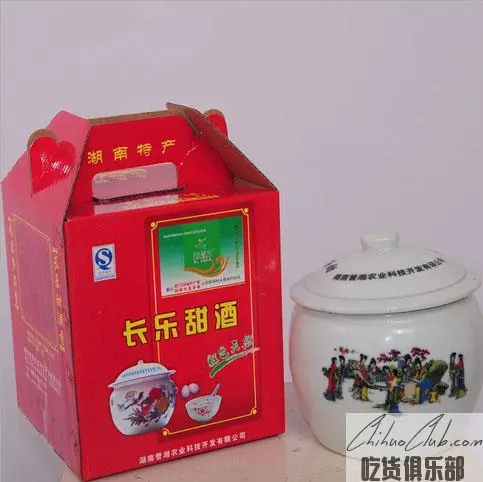
Changle liqueur
-
Update date::
-
Date of protection::
-
Protected range:The production area of Changle sweet wine is Changxin Village, Maqiao Village, Chima Village, Zhiyuan Village, Qingshi Village, Yousheng Village, Changnan Village, Qikou Village, Shuiyuan Village, Shuifu Village and Shuangqi, Changle Town, Miluo City, Hunan Province. Village, Shuihe Village, Baisha Village, Jiangbei Village, Guanglian Village and Eryue Temple Neighborhood Committee, Huilongmen Neighborhood Committee are under the jurisdiction of the administrative area.
-
Related origin:
-
Category:
The liqueur is called “醴” in ancient times and is famous for its sweet and delicious taste. Changle liqueur, out of the hustle and bustle, is not exactly the same as 醴. The brewing and fermentation of “醴” takes only one night, while the traditional Changle liqueur brews and ferments for 2 to 3 days, and the taste is better than “醴”.
The brewing of Changle liqueur began with a beautiful legend about filial piety during the Northern Song Dynasty. According to legend, a young man named Chen Yukun in Changle Zhaobi Lane inadvertently invented liqueur when he was serving a sick mother. Yuan Shun Emperor once praised: Drinking this wine for a long time, happy and forgetful. Emperor Qianlong of the Qing Dynasty, when he was in charge of Changle, he wrote the title "Changle Sweet Wine". Since then, Changle liqueur has been famous and famous for its four townships. In Changle Town, every household can make sweet wine, and every family must have sweet wine, which means sweetness. Changle liqueur, although the process is not complicated, but in the use of materials and containers, storage requirements are extremely particular. The rice wine for brewing uses the "three-inch" (also known as peach glutinous rice) of local specialties. The brewing water must use the well-drilled deep well water. The koji must use the sweet koji made from locally produced squid seeds, and use pottery. Products and bamboo products as a wine making tool. A bowl of liqueur that "sees the crystals of the crystals, the smell of the fragrance, the fragrance of the lips, and the fragrance of the food" can be called the authentic Changle liqueur. Changle liqueur won the title of National Geographical Trademark Protection Mark Product, Hunan Famous Trademark, China Central International Agricultural Fair Gold Medal, Yueyang Intangible Cultural Heritage, and Hunan Provincial Local Standardized Product. It has won 1 national, 9 provincial and 21 county-level honors, and has become a very distinctive "business card".
Technical requirements for quality of Changle liqueur 1. First, raw and auxiliary materials requirements 1. glutinous rice: 1.1. Variety: "Osmanthus fragrans" (commonly known as "three-inch"). 1.2. Chemical fertilizers and pesticides are banned during cultivation. 1.3. The harvesting time is around October 20th of each year. Immediately after harvesting, it is exposed to two days, then stacked for two days, and then re-dried to full dryness. The water content is ≤14%. 1.4. Processed into polished rice, the rice is full, the color is white and shiny, no impurities, no insect damage, no mildew. 2. Brewing water: deep well water is used, the well depth is ≥10 meters, and the water quality meets the national drinking water standard. 3. Liquor: Use local succulent seeds, sesame flowers and brown rice to make music. Other additives and excipients are prohibited. Second, the process selection material → Taomi → dip rice → Shangyu → rice dumpling → mix the song → the altar → into the 窖 → exit 窖 → packaging process safety: insulation, ventilation, moisture, clean. 1. Soak rice for about 4 hours. 2. Cook with firewood for 25-30 minutes. 3. Remove the rice soup and keep the rice grains fresh. 4. Keep the rice mixed at 10 °C - 15 °C. 5. The fermentation temperature is controlled at 35 ° C -40 ° C, and the fermentation time is controlled at 40-48 hours. 6. Cylinders, altars, enamels, enamels, etc. need to use ceramic products and bamboo and wood products, the process and quality must comply with relevant standards, banned plastic products. Third, the quality characteristics (a) sensory characteristics rice grains are white or milky white, the liquid is milky white, solid-liquid mixture, rice grains are even. Moderate soft and hard, the wine juice penetrates, the rice is rich and the taste is sweet. The rice is soft and hard. (2) Physical and chemical indicators Physical and chemical indicators Project indicators Alcohol (20 ° C) / (% vol) 3.0-5.0 total sugar (glucose) / (g / 100g) ≥ 10.0 solids / (g / 100g) ≥ 30.0 total acid ( In terms of lactic acid) / (g / 100g) ≤ 1.0 amino acid nitrogen / (g / 100g) ≥ 0.5 (three) safety and other quality technical requirements: product safety and other quality technical requirements must comply with relevant national regulations.
Apply to:
Producers within the scope of the production of Changle sweet wine may submit an application to the Miluo City Market and Quality Supervision Administration for the use of the “Special Mark for Geographical Indication Products”, which shall be reviewed by the Hunan Provincial Bureau of Quality and Technical Supervision and announced to the General Administration of Quality Supervision, Inspection and Quarantine for approval. The testing organization of Changle liqueur is selected by the Hunan Provincial Bureau of Quality and Technical Supervision in the testing institutions that meet the qualification requirements.